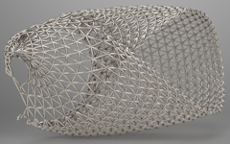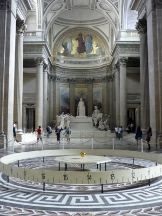Through a Glass Darkly – Deciphering the Micro- and Macrocosmos
Models for studying fundamental physics, astrophysics, and cosmology


One of the deepest and most vigorous debates in modern physics has involved attempts to find a reconciliation between Einstein’s Theory of General Relativity and Quantum Mechanics. The answers would affect our knowledge and understanding of both very large and very small systems profoundly, but progress has been elusive.
The Wolfram Summer School project, Through a Glass Darkly – Deciphering the Micro- and Macrocosmos, explores the early history of Special Relativity, General Relativity, and Quantum Mechanics and summarizes the main approaches to unification since then. What ideas have held the most promise? What unresolved issues have been left to the wayside? The research assesses what can (and must) be done through theory alone and what can be achieved experimentally with enhanced models, innovative technologies, and modern computing resources. While theoretical physics itself has not shown many breakthroughs over the past few decades, impressive advances in technology have revolutionized the fields of experimental physics and physical cosmology.

If we consider the history of cosmology, it is clear that even ancient astronomers had the desire to list, categorize, and theorize about different types of celestial objects. The Sun, the Moon, planets, and stars were observed, described, and even mythologized by people in every culture, with some of the earliest known mathematical research being done in Babylon and Greece. Although some of the closer, more familiar objects are reasonably well-understood today, we are still working on categorization and making fresh discoveries in our own solar system; the question of Pluto’s status in the early 1990s (since “downgraded” to a dwarf planet) and the recent discovery of 20 more moons than previously observed around Saturn (2019) are cases in point.
This field is in a constant state of flux – even the terminology can change and new objects are being observed quite often. Beyond the confines of our own system, astronomers have long been fascinated by cosmic anomalies, including black holes, pulsars, and quasars. We are not able to fully explain these phenomena, but our vision is getting better all the time.

Thus, through observation, experimentation, and theoretical adaptation, the fields of physics and cosmology are moving forward, sometimes with cascades of discoveries and inventions and sometimes through long, slow periods, where smaller scale work is accomplished before the next era unfolds.




This project briefly examines the history of physics and its leading thinkers and then turns to innovative technology and its role in advancing the scientific discourse. We then assess the theory of computation and the development of a completely new line of thought in scientific exploration, as expressed by Stephen Wolfram in his books A New Kind of Science (NKS, 2002) and A Project to Find the Fundamental Theory of Physics (PFFTP, 2020). Both NKS and PFFTP leverage decades of experience in developing computational tools and languages and studying complex dynamical systems in various environments.
By introducing a unique perspective on the pursuit of science, such works stimulate discussion and debate, helping physics move forward towards the next stage of understanding and insight. The project also envisions the creation of The Wolfram Museum of Fundamental Physics (WMFP), with both virtual and physical locations for physics information, artifacts, special exhibits, lectures, and experiments. The WMFP would serve as a gathering point and community resource in the years to come.

A Note to the Reader: This Wolfram Summer School project covers a wide range of complex topics in very brief terms. Naturally, there will be gaps and simplifications, particularly around the descriptions of 20th century physics, and the commentary on the books A New Kind of Science and A Project to Find the Fundamental Theory of Physics by Stephen Wolfram. Therefore, the reader is warmly encouraged to view this work as a roadmap to a wonderful adventure. Seek out the original sources; some starting points may be found in the References. Compile a personal library of related books and papers that radiate from there and bear in mind that, as with philosophy, poetry, and great literature, the most challenging works in physics will reward those who read, annotate, explore, discuss, and return to read again after mulling things over for a while. There is no time like the present, so let’s get started!
Photo Titles and Credits: 1) Gazing at the Universe, © NASA Images; 2) A Platinum Universe, created by Robert Mendelsohn, Wolfram Summer School, 2020; 3) The Flammarion engraving, L'atmosphère: météorologie populaire, 1888; 4) A pulsar within the galaxy Messier 82, detected by NASA's NuSTAR. Image: © NASA/JPL-Caltech; 5-8) Revolutionary thinkers: Albert Einstein, Erwin Schrödinger, Werner Heisenberg, and Richard Feynman; 9) Foucault's pendulum in the Panthéon, Paris